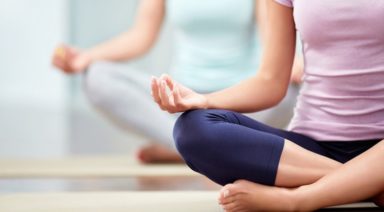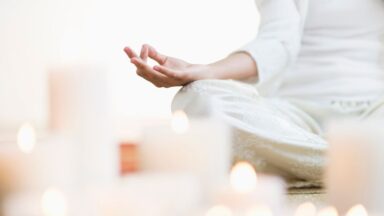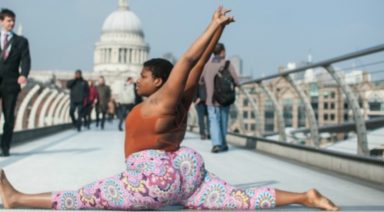Why You Need to Understand Your Kosha Energy

By now, you’ve probably read a decent amount on chakras, but have you ever taken note of your koshas? They are another vital bodily energy that those seeking to live holistically very much need to understand for a balanced life.
A Kosha (also, Kosa) (Sanskrit कोश, IAST: kośa), usually rendered “sheath”, is one of five coverings of the Atman, or Self according to Vedantic philosophy. They are often visualized as the layers of an onion. Basically, the koshas are energetic layers or sheaths that move from the outermost layer of skin to the deep spiritual core. The koshas provide a framework for conceptualizing ourselves. Much like the chakra system, the kosha layers come packaged with their own individual physiological function and psychology.
In some respects, the kosha layers mirror the psychology of the chakras. This is why it’s so important to have a firm grasp on the concepts, and to understand how each energy system can impact your body and life.
So what are the koshas, and how do they tie into you overall? Here are quick overviews of each kosha and the area it deals with, as well as a diagram for a visual picture of how the koshas work according to MindBodyGreen:
1. Annamaya: “Foodstuff” Sheath
The first layer of the koshas represents the physical body, including the skin, muscles, connective tissue, fat and bones. When you pinch the side of your waist and feel the skin and muscle under your fingers, you engage with annamaya kosha. For a lot of people the first layer might be where we spend the most time hanging out, locked in our physical senses
2. Pranamaya: “Energy” Sheath
The second layer represents the pranic or subtle body—in essence, it’s the circulatory system for prana, or “life-force energy.” It also includes the fluid, physical aspects of the anatomical body that control the movement of blood, lymph and cerebrospinal fluid through the body and the circulatory movement of breath through the respiratory system. In psychological terms, pranamaya kosha controls our bodily and spiritual rhythm.
3. Manomaya “Mindstuff” Sheath
The third layer takes us into the deep recesses of the mind, emotions and nervous system. While modern science has developed an acute understanding of the inner working of the brain, the mind, motivations and emotions still retain a mysterious quality. The manomaya kosha makes up the control panel for the emotional and physical body, sending messages through your brain synapses and the central nervous system. It’s this layer where you move from physical feeling and rhythm to emotional feeling.
4. Vijanamaya: “Wisdom” Sheath
Diving underneath the sea of emotions in the manomaya kosha, we reach the wisdom body of the fourth kosha—Vijanamaya. It’s here that we develop awareness, insight and consciousness. Emotions left unchecked by awareness are destructive. The awareness of vijanamaya kosha illuminates our deeper desires and motivation and allows us to see the choice we have in all things. Instead of simply feeling or acting, we choose to feel or act with intention. Sometimes the intention is simply to move past the emotion into pure sensation and bliss.
5. Anandamaya: “Bliss” Sheath
The fifth and last kosha drops from conscious awareness into the pure and radiant bliss body. Within the anadamaya kosha, you might experience connection with all things, liberation from suffering and a state of being often described as “in the flow.”
Throughout the day, notice yourself shifting between the koshas layers:
- Right now I feel hot.
- Right now I’m paying attention to my breathing.
- Right now I feel upset.
- Right now I understand why I reacted that way yesterday.
- Right now I’m deep in meditation.
- Right now I feel bliss.
Yoga helps you to create a track to the deeper subtle kosha layers, so they’re easier to access. As asana prepares the outer body, yogic breathing turns your attention to the pranic body. Lastly, yogic philosophy provides the tools for bringing awareness to your fluctuating emotional state of mind, so you can embody and radiate health and bliss.
For an even more in depth look, this colorful infographic provides visual insight:

Wisdom of the Five Great Elements

“The nitrogen in our DNA, the calcium in our teeth, the iron in our blood, the carbon in our apple pies were made in the interiors of collapsing stars. We are made of starstuff.”
Carl Sagan
This “starstuff” that Carl Sagan describes, refers to the elements. In the present-day study of our natural world, science has revealed to us 118 unique elements; these can also be thought of in more universal terms as space, air, fire, water and earth. Each of these Pancha Mahabhuta, five great elements, represents a state or quality of matter that can be observed through direct experience. With practice and attention, we begin to recognize these Pancha Mahabhuta within our elemental bodies as a reflection of those comprising the observable universe. In essence, we can attune our biorhythms to those of the world around us to bring greater balance and deeper cosmic connection into our lives — this is elemental medicine.
In the sister science of yoga, Ayurveda, the five great elements are presented from subtle to gross. As the elements progress from less dense to more dense, each one contains the essence of those coming before it. The balance of space, air, fire, water and earth inside the body can be continually regulated according to our needs through the food we take in, the cultivation and management of Prana (internal energy) and our interaction with the physical world. Chinese Zodiac Elements are also another way to explore this topic.
In this article, we will explore a cursory overview of the elements with guidance for developing elemental practices both on and off the mat. While this is by no means a complete prescription for elemental medicine, it is aimed at sparking curiosity while offering a few quick ways to invite elemental intelligence into daily life.
Elemental Medicine for Balancing Akasha (Ether / Space Element)
Akasha is the subtlest of all the five great elements and can be difficult to perceive. It is the element from which all things arise and to which all things return. It is the backdrop or the “space” that makes it possible for all the other elements to exist in relationship with one another. When hearing the word “space” we might first think of outer space — the cosmos and the sense of awe rushes over us when gazing up at the night sky. We might contemplate the infinite nature of the universe which inevitably yields acceptance of the unknown and joy in the unknowing. And while we can seek outside ourselves for answers, yoga gives us an opportunity explore the inner space of our consciousness with the same curiosity and wonder that we do outer space. When all other elements dissolve, we are left with the subtlety of spirit, this is Akasha.
Nourish
Akasha is inherently tasteless. To pacify, take in moist, dense, heavy foods. To activate, enjoy bitter foods that increase the Vata Dosha or consider a brief fast to experience emptiness in the digestive system. As the container for all others, when the 4 primary elements are in balance, Akasha is healthy.
Practice
Observe the negative space between your body and the ground in poses like Adho Mukha Svanasana and Plank. Experience how your body moves in relationship to the space inside the sanctuary of practice. Focus on single-leg standing balance postures to awaken the inner ears and practice expansion in all directions from your center.
Breathe
Place emphasis on the emptiness at the end of the exhale by holding the breath out as in Bahya Kumbhaka. Observe the space inside the ribcage as the lungs inflate by holding the breath in on an inhale, as in Antara Kumbhaka.
Sense
The sensory expression of Akasha is sound. Whether chanting aloud or listening to an external source, notice the resulting vibration of the subtle body, visualize the gentle pulsation of your organs and cells. Observe through direct experience the spatial relationship of sound and how it interacts with the surroundings, this is the teaching of Akasha.
Vibrate: The bija seed sound of the space element is HAM. Affirm: I am infinite potential and embodied spirit.
Elemental Medicine for Balancing Vayu (Air Element)
Vayu develops from and contains within it the essence of Akasha. It is the first manifested potential of ether as mobilized kinetic energy and represents the gaseous form of matter. In this state, particles move quickly and expand, giving it low density and a quality of lightness. In the elemental body, the air element governs all things that move and circulate — impulses from the central nervous system, kinetic energy pumping blood to every cell and the exchange of air inside the lungs. The most direct way to experience Vayu is through the breath. We take air in and breathe air out, feeding our bodies with up to 30,000 cycles per day. And yet, we often don’t recognize this element as nourishment. Consider however, that you can go 3 weeks without food (earth) and 3 days without water, but you can only go 3 minutes without air. The air element resides inside the heart chakra, Anahata, the place of our true nature and in our most natural state, we are joyful. When meditating on the air element, it helps to visualize Danielle Laporte’s poetic analogy.
“Happiness is like rising [champagne] bubbles — delightful and inevitably fleeting. Joy is the oxygen — ever present.”
Danielle Laporte
Nourish
To increase air inside the body, enjoy foods that are light and contain open space. Reach for apples, puffed rice and bitter root vegetables/greens. In general, however, Vayu tends to be susceptible to excess and therefore foods which pacify the air element inside the body can be very soothing. Nourish with warm foods having dense, oily qualities with sweet, salty and sour taste.
Practice
Enjoy postures that increase circulation and create expansion across the heart region. Focus equal emphasis on the front and back of the heart to increase mobility in the spine and rib cage. Prone or grounding backbends such as Dhanurasana and Ustrasana can balance the air element by energizing from a stable, rooted base.
Breathe
Practice belly breathing bringing attention to the movement the diaphragm and the ribcage during the cycles of inhale and exhale. Notice the cool, lunar inhale breath as the diaphragm descends and contracts. Then, feel the shift to the warm, solar exhale breath as the diaphragm rises and relaxes.
Sense
Vayu is associated with touch and governed by the sensory organ of the skin. This is the way we experience fluctuations in temperature and pressure. In practice, begin to notice the textural quality of any point of contact on your body. This could be contact with your mat or with the earth, contact with the fabric of your clothing or contact with your own skin. Then, start to notice the difference in the absence of contact. Does this feel like a void or is there something that can be perceived on the skin? This is the subtlety of the air element.
Vibrate: The bija seed sound of the air element is YAM. Affirm: I am the expression of divine movement in all forms.
Elemental Medicine for Balancing Agni / Tejas (Fire Element)
The fire element is the energy of accelerated change or dissolution. Containing the expansive essence of air and space, it transforms matter from one state to another. The introduction of heat changes matter from solid to liquid to gas and the removal of heat reverses the cycle. Agni is responsible for the churning of digestion, the energy of ideas and healthy mental function as well as the fuel for personal power. For this reason, when we think of the fire element, we most often think of extreme heating with movement that is erratic and unpredictable. Not unlike the fire that generated the explosive elemental power of the Big Bang. Yet, fire element is intrinsically meditative. One of the earliest forms of meditation for humans was to simply become mesmerized by gazing into the dancing flames. It is this quality that represents balanced Agni.
Striking balance of this element within the body is all about the practice of intelligent fire-keeping. We have to stoke the inner fire enough so that the flames do not weaken, but not so much that we “burn out” and consume all of our physical, mental and emotional resources. Excessive fire can manifest as ego — we push too hard or chase a particular outcome. When in balance, the fire element supports healthy, steady strength and a slow heating from the inside out. Agni is the energy of transformation.
“Tending the Heart Fire is not a cliché or a romanticism but is instead a tangible, practical, instinctual way of transforming the conditioned patterns that limit the flow of love.”
Shiva Rea
Nourish
Digestion serves as an indicator light for the fire element inside the body; healthy digestive function is generally associated with balanced Agni. In lieu of ice water with meals, which can extinguish digestive fire, try drinking room temperature water or warmer. To increase digestion, consider chewing a slice of ginger before meals or drinking spiced tea with coriander, fennel and cumin afterwards. And while heating is the primary manifestation of this element, it is important to balance with moisture and cooling to avoid dryness. As the dominant element in the Pitta Dosha, dietary considerations which pacify this constitution can help restore balance including cool foods with bitter, astringent and sweet tastes.
Practice
Igniting the fire element in practice involves core cultivation and circulation for internal heat. Be sure that the hands and feet are warm before practicing by gently rubbing them together to generate friction. Hand balancing postures as in Bakasana and Titibasana can be invigorating and increase the fire element so long as they are done so from a space of relaxation to avoid agitating Agni.
Breathe
One of the quickest ways to generate heat inside the body is through breath of fire or Kapalabhati. As you practice this method of fire breath meditation, notice the shift in your energetic body. As best as you can, maintain softness through the eyes and face by allowing the jaw to release and pausing between rounds to absorb the warmth and feel the immediate effects.
Sense
Agni is associated with the eyes and visual sensory function. It is through the eyes that we digest light and perceive form. To connect more deeply to Agni through the vehicle of the senses, allow your eyes to relax to the point of almost blurred vision. Notice the light and shadow with gentle boundaries and visualize the light as being “digested” and transformed into perceptions.
Vibrate: The bija seed sound for the fire element is RAM. Affirm: I am the transforming power of the primordial fire.
Elemental Medicine for Balancing Apas / Jala (Water Element)
The water element, Apas, evolves from and contains within it the qualities of ether, air and fire. With the cooling of matter from its light, airy form, the boundary becomes more defined while still remaining fluid. Water is dynamic and adapts to whatever container it occupies. When faced with obstruction or resistance, water doesn’t stop or struggle, it spontaneously changes its form and flows around the impediment following the path of least resistance. This is the simple, yet profound teaching of Apas. The breath, when fluid, guides us along this same path, flowing in and out of our deepest caverns to create slow change over time. Originating in Svadhisthana Chakra, water is the energy of our creativity. It represents our ability to adapt and go with the flow, helping to soften our hardened edges and connect us with our inner essence, beyond the physical form. Our inner ocean is a reflection of the vast oceans that are moved by the moon.
“It is easy to believe that we are each waves and forget that we are also the ocean.”
Jon J Muth
The water element governs all the biofluids that keep tissues healthy and functioning and in its most natural state, water flows. When the flow stagnates, problems can occur; in the body, this equates to poor circulation, sometimes resulting in illness or disease. Balancing Apas is perhaps the most important elemental medicine as it regulates the primary healing modalities and reduces inflammation.
Nourish
While it may seem obvious, the most direct way to influence the balance of Apas is by taking in water which includes both liquid and solid forms. Foods that are naturally sweet in taste tend to have high water levels and favoring these foods can increase Apas as needed. When in excess, the water element exhibits lethargy and sluggishness because it is heavier than the elements coming before it. As part of the Kapha dosha, management of water energy includes balancing Kapha qualities in nutrition.
Practice
Practice for the water element is anything that liberates. In asana, consider softening the fixity of alignment and allowing the joints to gently bend so the limbs are more fluid. Practice rhythmic, circular movement patterns that mirror the wave motion of this element and explore all four corners of the mat in mandala practice. As one of the primal energetic centers and the seed center for creativity, any practice that awakens the sacral chakra will be balancing for Apas. Offer special attention and support for the sacrum in deep twists and prone backbends to bring greater stability to this region; excess water and flexibility here can yield sacroiliac discomfort. Also, enjoy Abhyanga with tridoshic oil, such as sesame, to lubricate the major joints before practice.
Breathe
Focus on breath that is fluid and undulating. Over several rounds observe any areas where it feels jagged or restricted and while extending the spine begin to smooth the breath rhythm. Visualize and experience the breath as liquid while drinking every inhale. If you find that your nostrils or throat feel dry, you might try a steam bath or even lightly cover your nose and mouth with a soft cloth to maintain the natural moisture of your breath.
Sense
Apas is the vehicle for taste and is related to the tongue. This element facilitates the function of the taste buds and in its absence, we are unable to sense taste. Notice the subtle difference that occurs when you take a small sip of water and moisten your mouth before eating. With the eyes closed, dive into the complete sensory experience and observe the effect of the 6 Ayurvedic tastes: sweet, salty, sour, bitter, pungent and astringent.
Vibrate: The bija seed sound for the fire element is VAM. Affirm: I am a vehicle for the universal current of creation.
Elemental Medicine for Balancing Prithvi / Bhumi (Earth Element)
The earth element contains the wisdom and essence of all others and Prithvi or Bhumi represents matter in its solid state. In this state, matter is stable and the particles move slower, providing the necessary structure and stability for all forms of the universe. The earth element, alive in Muladhara Chakra and located at the base of the spine, is our connection to the instinctual body and is the most primal of all the five great elements. It is here that we experience intuition without awareness — our bodies and spirits do what they are designed to without interference from intellect.
With its smooth, steady rhythm, Prithvi draws us closer to the plane of the earth by letting everything go to gravity. This magnetic, earthly pull of consciousness supports the energy of manifestation where we put ideas into action. Elemental earth is present inside all the structures of the body — from cellular structures to organs, muscles and bones. It establishes the foundation upon which transformation can occur, like the sand beneath a beach bonfire.
Nourish
The earth element is the antidote to Vata imbalance and can be very soothing with heavy, dense foods. To increase the qualities of Prithvi in the body, reach for nuts, legumes and grains which can balance deficiency. When in excess, the earth element manifests as overeating or storing of the structures we take in from food, so smaller portions spread out over time can help reduce this tendency. The earth element also regulates Apana, the downward moving current in the body and is therefore responsible for elimination; constipation and diarrhea generally indicate an imbalance of this elemental energy. For constipation, sip tea made with ginger, lemon and honey on an empty stomach to increase movement. Excessive elimination can be an indication of poor absorption and formation which are earth qualities. Remedies include herbs and spices such as ghee, fennel and psyllium husk or a brief period of fasting to rest an overtaxed digestive fire.
Practice
Enjoy asana that create mobility and space across the pelvic floor and in the hips while activating strength in Mulabhanda. Use the hands and feet to press down and feel the support of opposite action from the ground. Practices that stay close to the plane of the earth will naturally cultivate Bhumi Shakti, earth-centered energy, and leave a residue of calm. Deep, ground-supported hip openers as in Malasana, Ardha Raja Kapotasana, Parighasana and Surya Yantrasana can attune the body’s rhythm to the stability of the earth element. Evolving from the freedom of the water element, begin to grow steady in your own structural alignment and observe how this affects the pathways of Prana inside the realm of practice.
Breathe
Focus on Apana Vayu, the downward-flowing current of breath as exhibited by the descent of the diaphragm on the inhale. Use the hands to trace the downward flow of breath with palms downward facing and feel the depth of the belly as the ribcage expands. Use the exhale to contract Mulabandha and support energy containment at the root as air exits the lungs and the belly draws in.
Sense
The earth element regulates the sense of smell and connects us to deeply stored memories. It is our most primal sense and yet it often goes unnoticed as a result of sensory overload in our vision, sound and feeling centers. The sense of smell, so intimately woven into our physical and energetic systems, has the ability to elicit a very specific response and as a result can be used for simple healing. Essential oils such as patchouli, vetiver and frankincense have earthy qualities and can bring tremendous calm to the senses by soothing excess upward energy.
As a meditation practice for your sense of smell, during your next meal take a moment to inhale the aroma before each bite. Can you distinguish the subtle differences between the taste experience and the experience of smell? Notice how the experience changes when the space is quiet or when you close your eyes.
Vibrate: The bija seed sound for the fire element is LAM. Affirm: I am the container for all forces in nature.




































